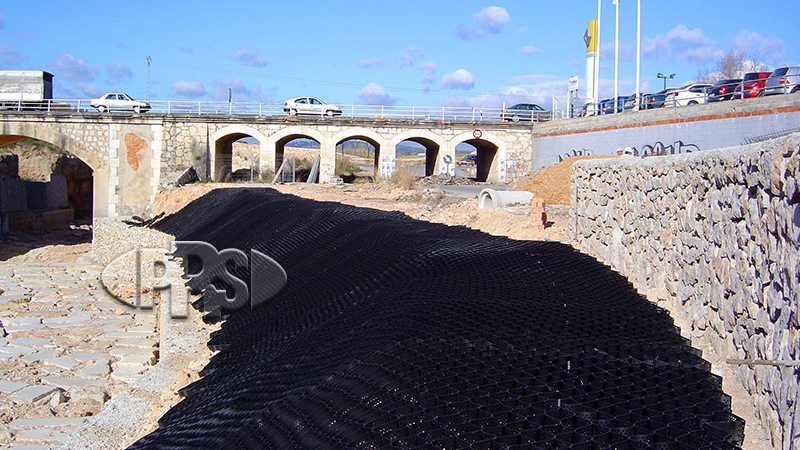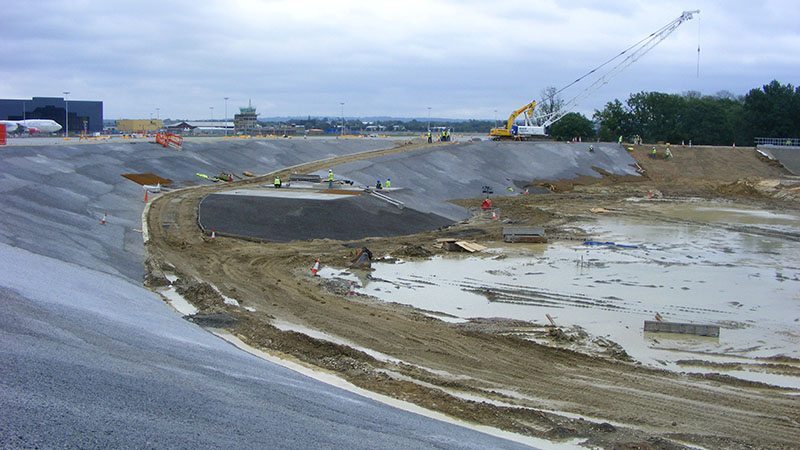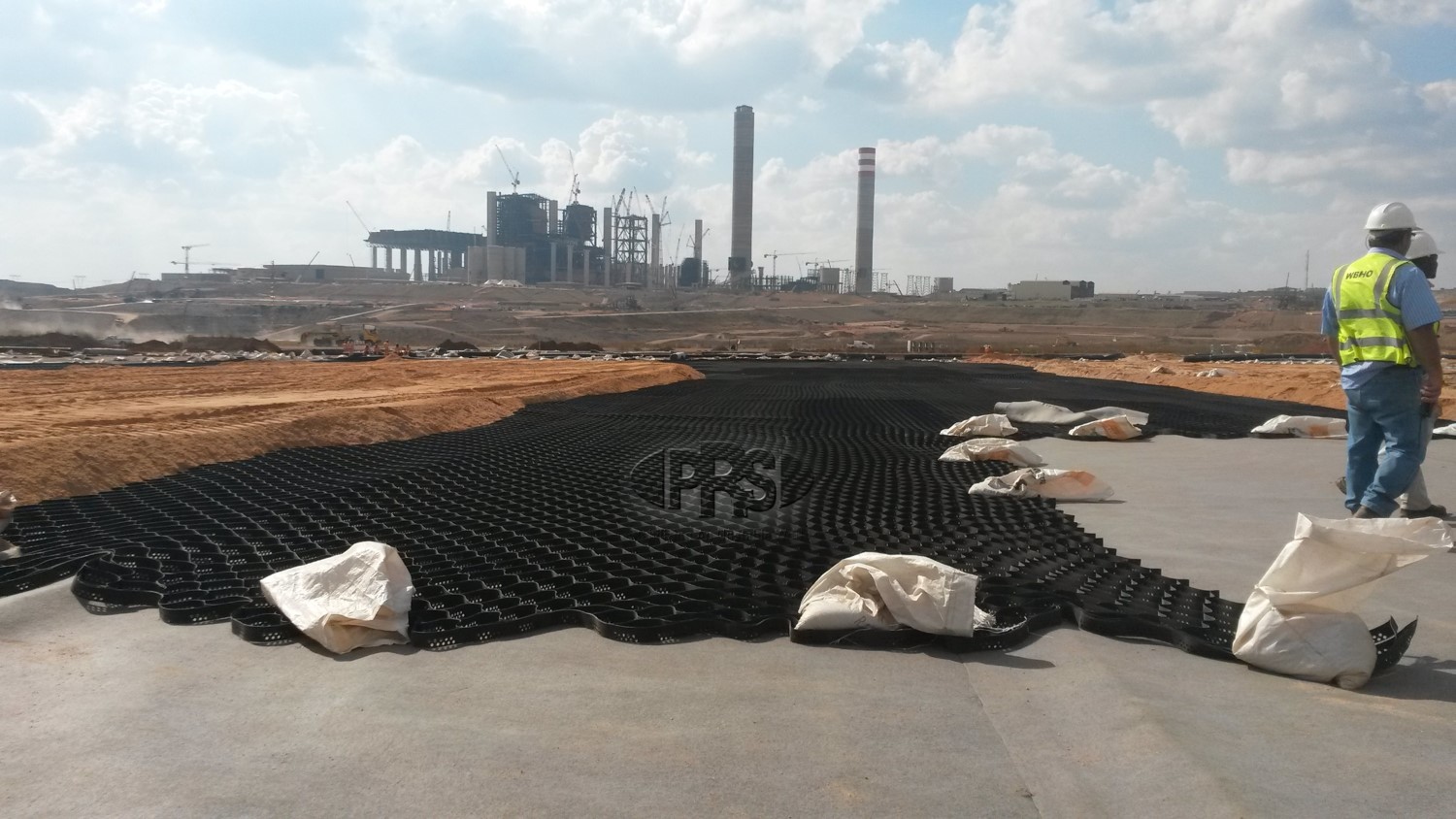Channels and drainage systems are often located near roads, railways, bridges, and other infrastructure. Erosion undermines these structures and leads to costly repairs or even failures. Channel protection is needed to improve infrastructure resilience and reduces the risk of disruptions to transportation and other essential services.
The contribution of geocells in channel applications is stabilization – to prevent erosion of in situ materials and protect the channel slopes and bed. In cases with severe mechanical or hydraulic forces, the use of concrete infill maximizes the strength and durability of the channel surfaces.
A Tough-Cell mattress filled with concrete hard armor is defined as a flexible concrete. The concrete is reinforced by the tensile capabilities of the Tough-Cell, so that it can absorb hydraulic forces and ground movements to resist cracking. e.g., in channel and drainage applications. Neoloy Tough-Cells made of NPA (Novel Polymeric Alloy) add high tensile strength, stiffness, and resistance to deformation creating the most resilient, and strongest yet flexible reinforced erosion control system.
Neoloy Tough-Cells are made from NPA (novel polymeric alloy) – which imparts high-tensile strength, elastic stiffness, creep resistance and environmental durability – the key properties required by ASTM, ISO and other international guidelines and standards. These properties translate to long-term dimensional stability and design strength for channel, canal and waterway protection with a reliable, long lifespan. Neoloy Tough Cells are non-degradable, and resistant to weathering, extreme temperatures and water, which can affect concrete, steel and timber solutions.
Neoloy® Tough-Cells offer proven reinforcement for concrete systems under hydraulic loads, ensuring reliable performance even in challenging flow conditionsץ Neoloy Tough-Cells add high tensile strength (>16 kN/m) in the 3D cell walls (hoop strength) to concrete without rebars. Tough cells create a stiff yet flexible concrete system that tolerates ground movements without cracking and has a high factor of safety. The amount of concrete can be reduced by 30-40% with no loss of strength and durability for significantly lower project costs.
Neoloy is easier to install, utilizes low-grade local granular infill and eliminates the need for underwater foundation work.
Sustainable – topsoil cover improves soil health, plant growth and visual landscape
Neoloy Tough-Cells are a sustainable drainage system (SUDS) or water management technique for the localized control of stormwater. Neoloy cellular confinement preserves the soil structure, tolerates high sheet-flow conditions and is self-draining for high infiltration into the soil.
Stormwater runoff, once considered a nuisance to be removed of as quickly as possible, is now considered a resource to be managed locally, close to where it hits the ground. The idea is to reduce the impact of built areas and promote the natural movement of water on-site by harvesting and infiltration to underground water sources.
Today’s planning policies and construction guidelines mandate water strategies based on integrated water management to seeks to mitigate the impact of surface water discharges, improve runoff quality, reduce the risk of flooding and augment potable water resources.
Neoloy Tough-Cells integrated in the structural layers of concrete paving block systems can best reduce stormwater by maximizing infiltration in structural layers, thereby reducing runoff and flooding and filtering pollutants. The high Neoloy Tough-Cell reinforcement factor enables the use of open grade aggregate, which has lower strength than engineered stone, but greater permeability.
Neoloy Tough-Cells preserve soil structure, tolerate high sheet-flow conditions and are self-draining for high infiltration into the soil.
Neoloy Tough-Cells are ideal for soil protection of contoured open-channel gravel drainage ditches, verges and bioswales used to manage stormwater runoff. They prevent soil erosion and channeling while providing an excellent growth medium for the growth of turf and vegetation or preventing aggregate movement in gravel ditches. This assists the on-site infiltration to reduce runoff, filter pollutants, prevent flooding and augment underground water resources.
In addition, Neoloy Tough-Cell stormwater management systems can be used with permeable pavement systems, such as concrete paving blocks to enhance pavement drainage.
Unique Neoloy® polymer – very high resistance to UV, oxidation, water, extreme temperatures
Neoloy Tough-Cells stabilize the soil, prevent erosion and enhance vegetative growth, protecting the waterway from high water velocity and tractive forces.
Natural river banks and shorelines sometimes need riverscape engineering to protect them from erosive forces. Neoloy Tough-Cells stabilize the soil, prevent erosion and enhance vegetative growth, while protecting the waterway from high water velocity and tractive forces. Anchorage systems can be integrated to further prevent uplift forces and enhance slope stability.
Neoloy withstands alternative tension and compression and saturated conditions without losing its structural integrity. Neoloy offers integrated solutions, such as concrete infill of retaining walls along the lower shoreline subject to high flow velocities, with vegetated soil/slope stabilization of the upper banks that are subject to more intermittent and lower velocity flows.
Neoloy confinement of vegetated soil, hard armor or poured concrete fill optimizes erosion protection for natural or man-made channels and hydraulic structures, typically incorporated into open-channel systems. Typical solutions for a channel depend on the hydraulic, site and environmental conditions along a water course include Neoloy Tough-Cells with:


Neoloy Tough-Cells are a sustainable drainage system (SUDS) or water management technique for the localized control of stormwater. Neoloy cellular confinement preserves the soil structure, tolerates high sheet-flow conditions and is self-draining for high infiltration into the soil.
Stormwater runoff, once considered a nuisance to be removed as quickly as possible, is now considered a resource to be managed locally, close to where it hits the ground. The idea is to reduce the impact of built areas and promote the natural movement of water on-site by harvesting and infiltration to underground water sources.
Today’s planning policies and construction guidelines mandate water strategies based on integrated water management to seeks to mitigate the impact of surface water discharges, improve runoff quality, reduce the risk of flooding and augment potable water resources.
Neoloy Tough-Cells integrated in the structural layers of concrete paving block systems can best reduce stormwater by maximizing infiltration in structural layers, thereby reducing runoff and flooding and filtering pollutants. The high Neoloy Tough-Cell reinforcement factor enables the use of open grade aggregate, which has lower strength than engineered stone, but greater permeability.
Neoloy Tough-Cells preserve soil structure, tolerate high sheet-flow conditions and are self-draining for high infiltration into the soil.
Neoloy Tough-Cells are ideal for soil protection of contoured open-channel gravel drainage ditches, verges and bioswales used to manage stormwater runoff. They prevent soil erosion and channeling while providing an excellent growth medium for the growth of turf and vegetation or preventing aggregate movement in gravel ditches. This assists the on-site infiltration to reduce runoff, filter pollutants, prevent flooding and augment underground water resources.
In addition, Neoloy Tough-Cell stormwater management systems can be used with permeable pavement systems, such as concrete paving blocks to enhance pavement drainage.
Neoloy confinement, when combined with geomembrane gives the highest and reliable protection to reservoirs, in all conditions and situations.
The mission critical objective of reservoirs is to provide 100% protection of the reservoir geomembranes while creating stable soil, berms and slopes.
Neoloy cellular confinement from PRS combined with geomembranes creates protected, impermeable, non-slip and durable impoundment of water, waste and leachate. Liners are shielded by Neoloy Tough-Cells from natural, accidental or intentional damage. Used in applications that require containment, treatment or control of water, or other liquids, Neoloy Tough-Cells are installed on top of a geomembrane on the slopes of the reservoir or containment pond. The Neoloy Tough-Cells are easily filled with concrete for effective and reliable long-term protection.
Neoloy Tough-Cells are impervious to salinity, corrosion, acidity, sewage and extreme temperatures. Neoloy cellular confinement systems have considerably higher environmental resistance and durability than HDPE-based Soft-Cells.

Neoloy® Tough-Cells create the most durable and strongest impoundment berms for waste containment and treatment. The cover system for waste containment facilities is designed to minimize infiltration and erosion and control egress of decomposition gases from municipal solid waste. The cover system must have an erosion control layer underlain by an infiltration control layer.
Integrated with geomembrane protection Neoloy Tough-Cells create impermeable, durable impoundment berms for waste containment and treatment. Neoloy slope protection is used to maximize the capacity of modern municipal solid waste landfills, by allowing significantly steeper and higher covers. This includes the protection and stabilization of steep slope surfaces and reinforcement of subbase of bottom liners.
Neoloy creates a soil stabilization system that holds the infill material in place and prevents mass movements by providing tensile reinforcement. Neoloy Tough-Cells also improve the structural and functional behavior of soil infill materials. Filled with concrete, Neoloy is an environmentally safe and non-corrosive solution for mining waste, chemicals, slurry and sludge.
